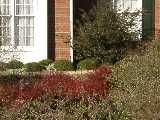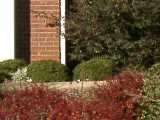Casio QV-2300UX PlusA 2 megapixel swivel-lens design with lots of creative options and a 340-megabyte Microdrive included (US only)<<Reference: Datasheet :(Previous) | (Next): Print-Friendly Review Version>> QV-2300UX Sample ImagesReview First Posted: 1/29/2001 |
| We've begun including links in our reviews to a Thumber-generated index page for our test shots. The Thumber data includes a host of information on the images, including shutter speed, ISO setting, compression setting, etc. Rather than clutter the page below with *all* that detail, we're posting the Thumber index so only those interested in the information need wade through it! ;) |
|
|
Outdoor portrait: (813k) The extreme tonal range of this image makes it a tough shot for many digicams, which is precisely why we set it up this way. The object is to hold highlight and shadow detail without producing a "flat" picture with muddy colors, and the Casio QV-2300UX Plus' white balance system does an excellent job. We shot samples of this image in the automatic (835k), daylight (834k), and manual (832k) white balance modes, choosing the manual setting for our main series. Both the automatic and daylight settings produced warm results, with predominantly magenta tones. Color balance looks good throughout the image, particularly in the blues of the flowers and pants, which are nearly accurate. (These blues are quite difficult for many digicams to reproduce correctly.) The skin tones also look good, though maybe a touch dull, and the red flowers are in check (this red is sometimes reproduced too vibrantly). Resolution looks good, with a lot of detail visible around the model's face and in the flower bouquet. The overall image appears slightly soft, though not enough to be too distracting. A nice amount of detail is also present in the shadow areas, and noise is minimal and finely grained. Our main image was taken with no exposure adjustment, which did the best job of adequately exposing the shadow areas without overexposing the highlight areas too much (though the highlights of the white shirt and flowers are a little blown out). (This was an unusual exposure setting for this subject: The overall brightness causes most cameras to overexpose the shot.) The table below shows the results of a range of exposure settings from zero to +1.3 EV. Exposure Compensation Settings:
|
||||||||||||||||||||
|
|
Closer portrait: (805k) The QV-2300UX Plus also does a great job with this closer, portrait shot, without any distortion, thanks to its 3x lens. (Shorter focal length lenses tend to distort facial features in close-up shots like this and the availability of longer focal lengths is a key feature if you're going to be shooting close-up people shots.) Continuing with the manual white balance setting, we again shot our main image with no exposure adjustment. (This close-up shot generally requires less exposure compensation than the wider Outdoor Portrait: The QV-2300's exposure system seemed to handle both this and the more distant portrait equally well.) Resolution looks even better in this shot, and fine details look much sharper and crisper than in the wider Outdoor Portrait, especially in the sunlit strands of the model's hair. Noise remains moderate and fine grained in the shadow areas. A very nice job overall. The table below shows the results of a range of exposure settings on the QV-2300UX Plus, from zero to +1.0 EV. Exposure Compensation Settings:
|
||||||||||||||||||||
|
|
Indoor Portrait, Flash: (811k) The QV-2300UX Plus' built-in flash does a nice job of illuminating the subject without washing out the color balance. We shot our first series with the QV-2300UX Plus' internal flash, at the Strong (757k), Normal (758k), and Weak (736k) intensity settings. As you'd expect, the flash intensity is very low at the Weak setting, barely lighting the model at all. We also noticed just the slightest orange tint in the background. The Normal setting appears much dimmer than we'd expect to see, but softly lights the subject. With the Strong intensity setting, the flash power intensifies further, practically eliminating the orange tint but not blowing out the highlight areas. A warm cast is still present, but is much more subtle in the background. Color balance with all three images looks close to reality, though color saturation is slightly subdued. We next shot with the camera's Night Scene mode, which combines the flash with a slower shutter speed to let in more of the ambient light. Again, we shot with the Strong (811k), Normal (816k), and Weak (822k) intensity settings. Because the slower shutter speed allows more ambient light into the image, each of the images taken in Night Scene mode have a noticeable orange cast. Despite the orange tint, the images are much brighter overall, with the most pleasing results again achieved with the Strong intensity setting. At the Strong setting, the flash is bright enough to render the best white value on the model's shirt. Overall color balance also looks pretty good. In all of the flash exposures, we noticed that the flash manages to light the subject without producing extreme shadows in the background. An excellent performance. |
||||||||||||||||||||
|
|
Indoor portrait, no flash: (757k) This shot is always a very tough test of a camera's white balance capability, given the strong, yellowish color cast of the household incandescent bulbs used for the lighting, and the QV-2300UX Plus' white balance system overcomes this obstacle with ease. This time, we tested the automatic (765k), manual (763k), and incandescent (760k) white balance settings, choosing the manual setting as the most accurate. The automatic setting resulted in a cool, bluish image, while the incandescent setting produced a warm, yellowish cast. Color balance in the manual setting looks great, though just slightly warm. We also noticed that the overall color appears a little undersaturated, but the skin tones and flowers look about right in hue. (We found though, that an "auto levels" operation in Photoshop(tm) cleaned the image up beautifully, as seen here.(323k) ) We shot our main image with a +0.7 EV adjustment, which produced the best overall exposure. That said, there is an odd blue highlight on the model's shoulder opposite the flowers. This may have been the first sign of an odd behavior we encountered as we pushed the positive exposure compensation further: At compensation settings of +1.0 and +1.3 EV, the colors shifted drastically, with the highlights taking on a fluorescent green tinge. (See the links in the table below.) Resolution looks good throughout the image, with fine detail visible in the model's necklace, hair, and flowers. Some pixelation is noticeable though, at the boundary between the red and blue flowers. (Not an uncommon digicam artifact, but more pronounced here than we're accustomed to seeing.) A moderate noise level is present throughout the image, particularly noticeable in the model's hair and face. We also tested the camera's variable ISO settings, shooting at the 160 (867k) and 320 (828k) ISO equivalents (our main shot was taken at the ISO 80 setting). We found that as the light sensitivity increased, so did image noise, becoming markedly stronger at the 320 setting (enough to detract significantly from the image quality). Additionally, the 320 setting produced a warmer, slightly dimmer image. The table below shows a range of exposure adjustments from zero to +0.7 EV. Exposure Compensation Settings:
|
||||||||||||||||||||
|
|
House shot: (842k) NOTE that this is the "new" house shot, a much higher-resolution poster than we first used in our tests. To compare the image of the QV-2300UX Plus with previously tested cameras, here's a shot of the original house poster in the automatic (877k) white balance setting. We shot samples of this image with the automatic (133k), daylight (132k), and manual (133k) white balance modes, this time choosing the daylight setting for our main series. (It was actually a bit of a tossup between the white balance options: Auto was a bit cool, Daylight a bit warm, Manual a bit green. We flipped a coin and picked Daylight.) Resolution looks pretty good, with a fair amount of detail visible in the tree limbs, shrubbery, and bricks, though the overall image is quite soft. Still, we distinguished the subtle details of the bricks and in the leaves of the trees. A moderate amount of noise pervades the roof shingles, as well as the shadow areas across the house front. About a pixel of a halo effect around the light and dark edges of the white trim along the roof line gives away the in-camera sharpening. The table below shows the full range of resolution and quality settings.
Sharpness Series We also shot with the camera's variable sharpness adjustments. The High setting does a nice job of increasing the image sharpness without altering the contrast too much, or creating too great a "halo effect" at contrast boundaries. Contrast is altered slightly, but not enough to make any major difference in the image as a whole.
Contrast Series The QV-2300UX Plus also offers an image contrast adjustment, which does a great job of increasing and decreasing the contrast without affecting the brightness level too much. While the low contrast option dims the image somewhat, and the high contrast one brightens it overall, neither is too severe an effect when compared to what we've seen with contrast options in some other cameras. Overall, a useful feature.
Saturation Series Color saturation can also be adjusted on the QV-2300UX Plus. All three settings perform nicely, increasing or decreasing the tonal saturation just enough without changing the contrast or hue values.
|
||||||||||||||||||||
|
|
Far-Field Test (866k) This image is shot at infinity to test far-field lens performance. NOTE that this image cannot be directly compared to the other "house" shot, which is a poster, shot in the studio. The rendering of detail in the poster will be very different than in this shot, and color values (and even the presence or absence of leaves on the trees!) will vary in this subject as the seasons progress. In general though, you can evaluate detail in the bricks, shingles and window detail, and in the tree branches against the sky. Compression artifacts are most likely to show in the trim along the edge of the roof, in the bricks, or in the relatively "flat" areas in the windows. We shot samples of this image with the automatic, cloudy, daylight, and manual white balance modes, choosing the automatic setting for our main series. Both the cloudy and daylight settings produced warm, slightly magenta results, while the manual setting appeared a little greenish in places. Overall color balance looks good in the automatic setting, though maybe just a hint warm. This shot is a strong test of detail, given the practically infinite range of fine detail viewable in a natural scene like this when seen from a distance. Resolution looks pretty good, judging by the pine needles and tree branches against the sky, as well as the brick details. Again, we noticed that the entire image is a bit soft. We also judge a camera's dynamic range in this shot, comparing how well the camera holds detail in both the shadow and highlight areas. The QV-2300UX Plus shows a somewhat limited range, losing all but the most prominent details in the bright bay window area. The dark shadow area over the doorway also shows a minimal amount of detail. Noise is minimal in the roof shingles and shadow areas, with a very fine grain pattern that we've noticed throughout our testing. We also snapped images at the 80 (866k), 160 (823k), and 320 (886k) ISO settings, noticing that the overall exposure darkened very slightly as the ISO setting increased. As usual, noise also became more pronounced with the higher ISO settings. The table below shows the full resolution and quality series.
Sharpness Series The camera's variable sharpness settings again did a good job of sharpening and softening the image, without affecting the contrast too much.
Contrast Series In this shot, with the High contrast adjustment, the overall image appeared much brighter. Likewise, the Low adjustment dimmed the image. Because of the heightened contrast in the High setting, the image also appears slightly sharper.
Saturation Series The saturation adjustments had a very noticeable effect on the Far shots, as the Low setting not only diminishes the intensity of the colors significantly, dulling the image quite a bit. The High setting is also quite effective, brightening the entire image and making the colors very vibrant. (We're puzzled by the greater effect this adjustment had on this shot than the House poster test target.)
|
||||||||||||||||||||
|
|
Lens Zoom Range We've received a number of requests from readers to take shots showing the lens focal length range of those cameras with zoom lenses. Thus, we're happy to present you here with the following series of shots, showing the field of view with the lens at full wide angle, the lens at full 3x telephoto and the lens at full telephoto with 2x and 4x digital telephoto enabled. The field of view at full wide angle is quite large, with barely any barrel distortion perceptible. The overall image noticeable sharpens with the 3x telephoto setting, and the prominent details return to the bright white paint of the bay window. The 2x digital telephoto gets closer in, and manages to maintain a reasonable amount of resolution and sharpness, with little noise. The 4x digital telephoto setting, however, becomes much softer with only a slight loss of resolution and rise in noise. (All of these images were shot at the camera's 800 x 600 resolution. At this image size, the 2x digital telephoto looks fine, since the 800 x 600 image size corresponds to the area it's cropping out of the center of the CCD sensor array. The 4x digital telephoto interpolates to enlarge a 400 x 300 block of sensor pixels to the 800 x 600 size, and the sharpness suffers accordingly.)
|
||||||||||||||||||||
|
|
Musicians Poster (826k) We shot samples of this target using the automatic (381k), daylight (378k), and manual (377k) white balance settings, again choosing the automatic setting for our main series. Both the automatic and daylight settings produced similar, warm images, with a somewhat orange cast overall. The manual setting by comparison was rather cool. (The large amount of blue in the image often tricks digicams into overcompensating, and the QV-2300 apparently somewhat fell prey to this challenge.) As with the indoor portrait shots, a simple "auto levels" operation in Photoshop greatly improved the color rendition, as seen here.(528k) Color balance in the Oriental model's blue robe is about right (this is a common problem area for digicams, as it's a hard blue to reproduce correctly), and the skin tones look good as well. Resolution also looks nice, as the bird wings and silver threads on the blue robe show good detail. The color gradations on the wings are visible, but the details of the bird legs are a little pixelated. The violin strings appear reasonably sharp, but we detected a slight moire pattern. Noise is moderate in the background and shadow areas, some of which could be from the actual poster. Below is our standard resolution and quality series. Resolution/Quality Series
Contrast Series We again shot a series of contrast adjustments, noticing that the High setting appeared to brighten the highlights too much. Adjusting the contrast to Low dimmed the image a good bit as well.
Saturation Series Below are each of the camera's saturation settings. In addition to intensifying the color saturation, the High setting also appeared to increase the orange cast.
|
||||||||||||||||||||
|
|
Macro Shot Coming Soon! |
||||||||||||||||||||
|
|
"Davebox" Test Target (765k) We shot samples of this target using the automatic (175k), daylight (175k), and manual (174k) white balance settings, choosing the manual setting for our main series. Both the automatic and manual settings produced similar results, with a slight red-orange color cast overall. The daylight setting resulted in a slightly warm, yellowish image. Color balance looks reasonably vibrant in the large color blocks, though nearly all of them appear slightly undersaturated, the yellow and green most visibly. The bright red and blue color blocks have about a pixel of a halo effect around their edges. The QV-2300UX Plus distinguishes between the red and magenta color blocks on the middle, horizontal color chart (a problem area for many digicams), though both blocks appear slightly weak. Exposure is a little too bright, as the subtle tonal variations of the Q60 chart are just barely visible up to the "B" range (another common problem area for digicams). The tonal gradations of the vertical gray scales are also completely visible, though the last two blocks of the darker end blend together. A nice amount of detail is visible in the shadow area of the briquettes as well as in the bright highlights of the white gauze. We also shot at the 80 (765k), 160 (854k), and 320 (847k) ISO settings. We noticed that the slight magenta cast disappeared with the 160 and 320 ISO settings, though the noise level increased with each higher setting. Color saturation also seemed to intensify just slightly. Below is our standard resolution and quality series. Resolution/Quality Series
Saturation Series With this shot, the saturation adjustments did a very nice job of intensifying and deintensifying the color blocks. The High setting produces more accurate color in the large color blocks, at the same time increasing the halo effect around the bright red and blue blocks. As we've noticed in our other tests, the Low setting decreases the vibrancy and dims the image slightly.
|
||||||||||||||||||||
|
|
Low-Light Tests The QV-2300UX Plus did a great job in the low-light category, as we were able to obtain bright, useable images at light levels as low as 1/16 of a foot candle (0.67 lux), at all three ISO settings. (1/16 of a foot-candle is really dim!) Color balance was rather warm at the lower light levels, but gradually cooled to a normal level as the light level increased. Noise levels stayed relatively low at the ISO 80 and 160 settings, but increased at the 320 setting. Despite being more prevalent, the noise level at ISO 320 is still not the worst we've seen. To put the QV-2300UX Plus' low light performance into perspective, an average city night scene under modern street lighting corresponds to a light level of about one foot candle. The table below shows the best exposure we were able to obtain for each of a range of illumination levels, at each of the available ISO settings. Images in this table (like all of our sample photos) are untouched, exactly as they came from the camera. |
||||||||||||||||||||
|
|
Flash Range Test (This test was added in August 1999, so cameras tested before that time won't have comparison pictures available. As we go forward though, all the new models will have similar tests available). Casio rates the QV-2300UX Plus' flash as effective from 1.6 to 6.5 feet (0.5 to 2.0m). (This is a very limited range relative to other digicams we've tested.) In our testing, we found the brightest flash exposures at the eight foot mark (the minimum distance we test at), with intensity decreasing gradually all the way to 14 feet. From 12 to 14 feet, the flash power becomes very dim. Below is our flash range series, with distances from eight to 14 feet from the target and the flash intensity set to Normal power.
|
||||||||||||||||||||
|
|
ISO-12233 (WG-18) Resolution Test (647k) In our resolution test, the QV-2300 shows visible detail out to about 700 lines per picture height in both horizontal and vertical directions, but some aliasing begnis at around 550 lines in both directions. Accordingly, we'd "call" the overall resolution at 600 lines per picture height, both vertically and horizontally. Sharpness is a bit below average among competing models we've tested. Overall a middle of the road performance in the resolution department. Resolution Series, Wide Angle
Sharpness Series
Resolution Series, Telephoto
Sharpness Series
|
||||||||||||||||||||
|
|
Viewfinder Accuracy/Flash Uniformity We found the QV-2300UX Plus' LCD monitor to be rather tight as LCD viewfinders go, showing about 87 percent accuracy at wide angle (313k), and about 86 percent at the telephoto (294k) setting (for both image sizes). We generally like to see LCD monitors as close to 100 percent accuracy as possible, so the QV-2300UX Plus falls a little short in this area, in our opinion. Flash distribution looks pretty even at wide angle, with just a hint of falloff around the edges and corners. Optical distortion on the QV-2300UX Plus is moderate at the wide angle end, as we measured 0.52 percent barrel distortion there. The telephoto end showed a surprisingly high 0.92 percent pincushion distortion. The barrel distortion at wide angle is a bit less than average among the cameras we've tested, but the pincushion distortion is quite a bit worse. Overall, we'd rate the lens a bit poorer than average with regard to distortion. Chromatic aberration is moderate, showing about two or three pixels of coloration on each side of the black target lines. (This distortion is visible as a very slight colored fringe around the objects at the edges of the field of view on the resolution target.) Chromatic aberration is most visible at the bottom of the frame in wide angle mode, but other than that, is surprisingly slight. |
||||||||||||||||||||





Follow Imaging Resource: